Before getting to Badami, we made a stop by a large temple tank called Haridra Teertha. Such tanks, more like pools, are called pushkarini in Sanskrit, but they also have other names depending on the language that is spoken in the given place.
These pools are built beside temples and are used for ritual cleansing and during the consecration since it is believed that the water in them is holy. However, they are quite regularly used for washing laundry and often children also enjoy in them as if these were proper swimming pools.
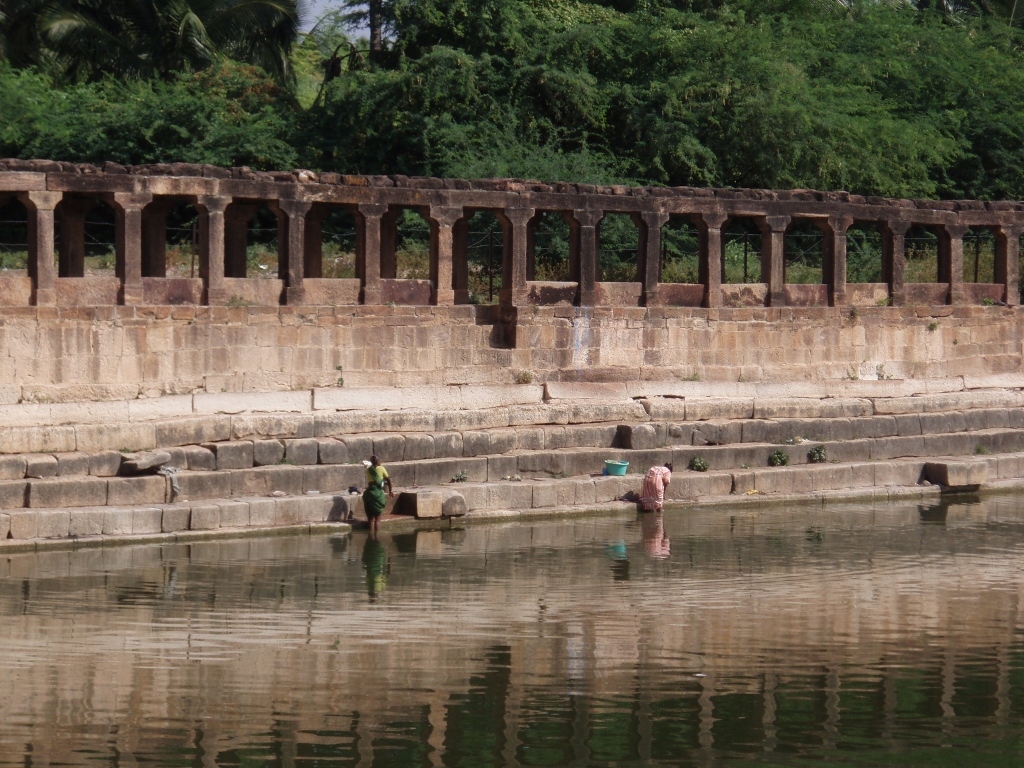 Haridra Teertha temple tank
Haridra Teertha temple tank
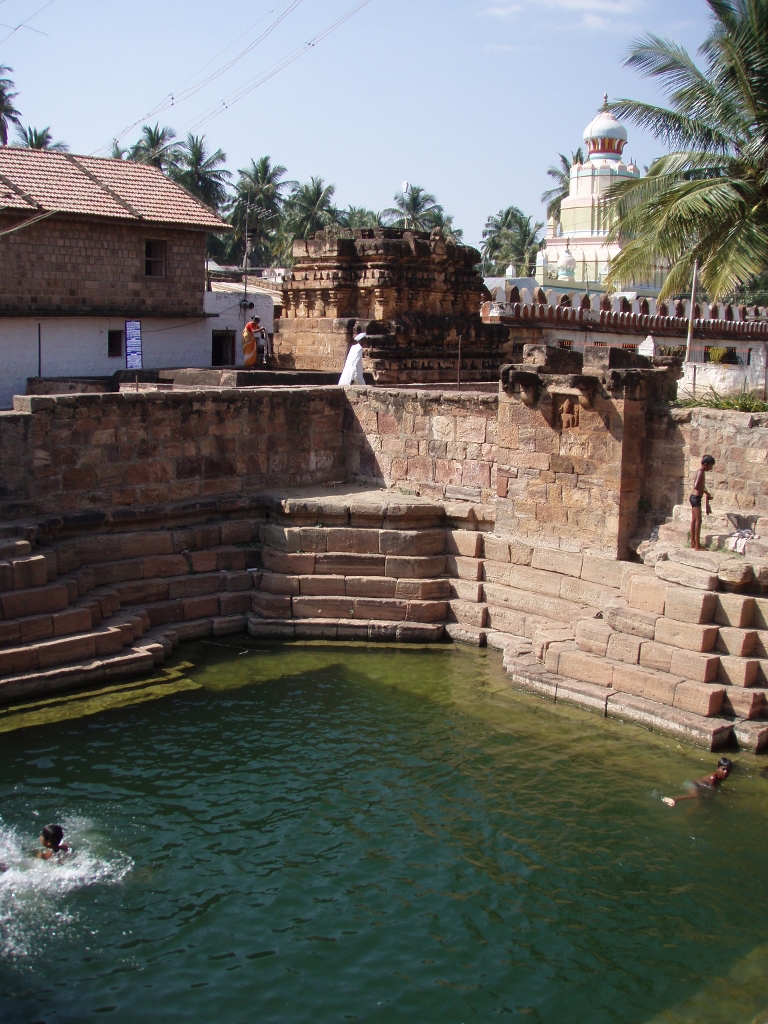 Children splashing in a smaller tank closer to the temple
Children splashing in a smaller tank closer to the temple
Soon we arrived in Badami. This is a village with 25000 inhabitants!!! After all, we were in India that is getting closer to China in terms of the incredibly high number of residents. What is culturally most important in this village are temples chiselled in rocks. There are four of them, at least of those main ones that we visited. Also, there are numerous other temples that we could not reach by car and as for walking to them, we neither had the time nor admittedly much will. Still, I do think that it would be perfect if one came here and spent a couple of days visiting all that is interesting.
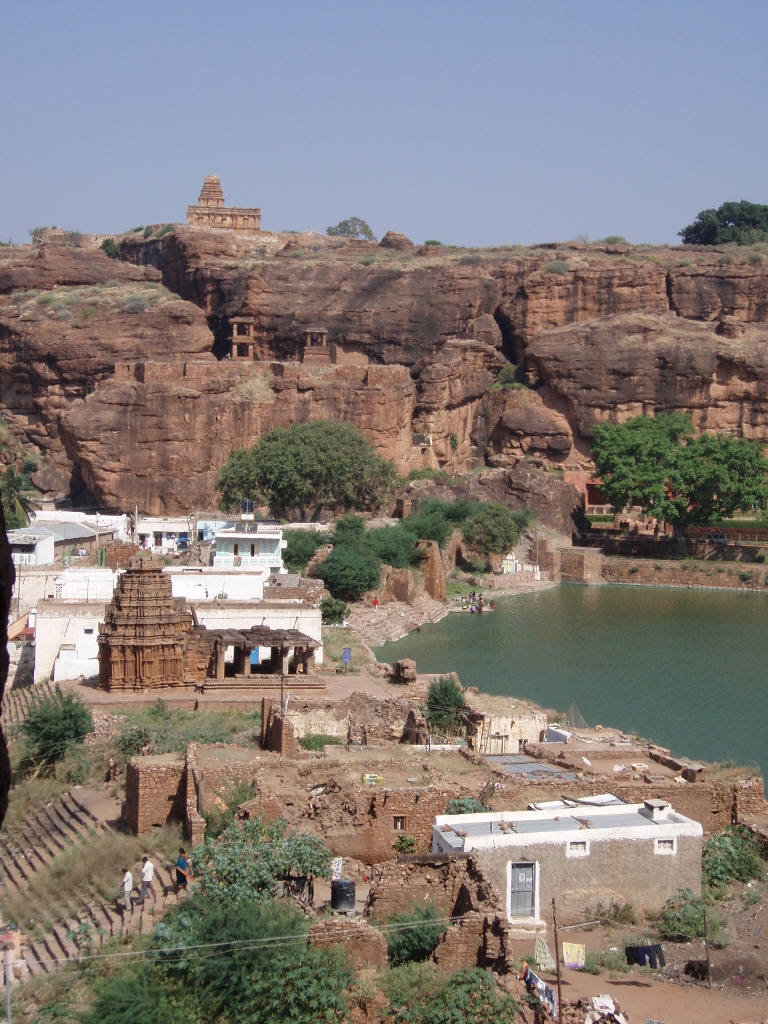 Parts of Badami and numerous temples
Parts of Badami and numerous temples
All those temples, as well as the surrounding rocks made of red sandstone are truly fascinating. We started to climb steps that led between such red rocks towards the first cave and from the spacious terraces that exist in front of the caves there is a beautiful view not only at the surroundings, but primarily at the man-made Agastya lake that is used as the temple tank around which there are several temples. The lake is also used for other purposes and thus there are pedal boats, but there are also women washing their laundry on its ghat. All the water was green and a good section was covered by pond scum, however, this did not seem to bother anybody. Even with this, the sights were stunning nonetheless and anything that could possibly seem dirty or imperfect did not disturb in any way the exceptional general picture of the place.
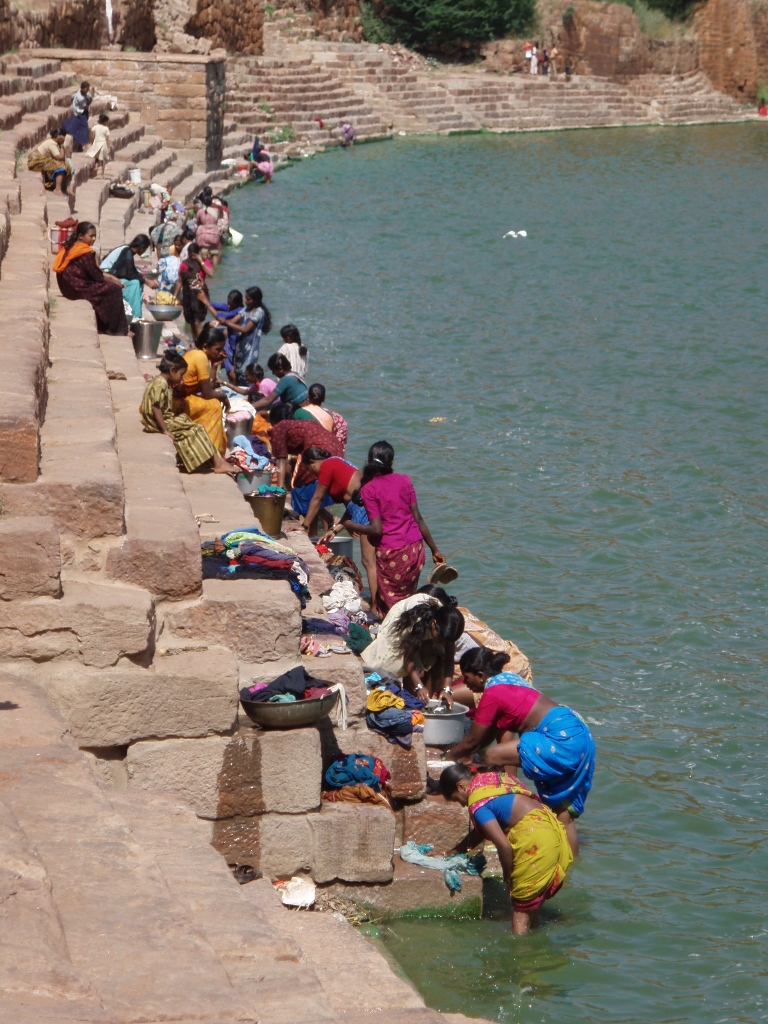 Hardworking women of Badami are washing clothes on the ghat of Agastya lake
Hardworking women of Badami are washing clothes on the ghat of Agastya lake
The four caves I’m talking about here are actually not proper, natural caves, but rather they have been chiselled out in the rock. Sneža and I had already encountered this type of “construction” back in Mumbai at the very beginning of our journey when we visited the Elephanta Caves (https://www.svudapodji.com/en/india-2/).
All the temples in Badami, as well as these four caves, were made when this place was the capital of the powerful rulers from the Chalukya dynasty that ruled a good portion of the Deccan plateau in the period from 540 to 757 CE. By the way, the Deccan plateau covers most of central and south India.
Cave 1 is approached by a long staircase and that cave is dedicated to god Shiva. The cave itself or rather the temple consists of a veranda, a central hall filled with pillars that carry the weight of the ceiling, while in the back of the cave there is a small shrine with Shiva’s lingam.
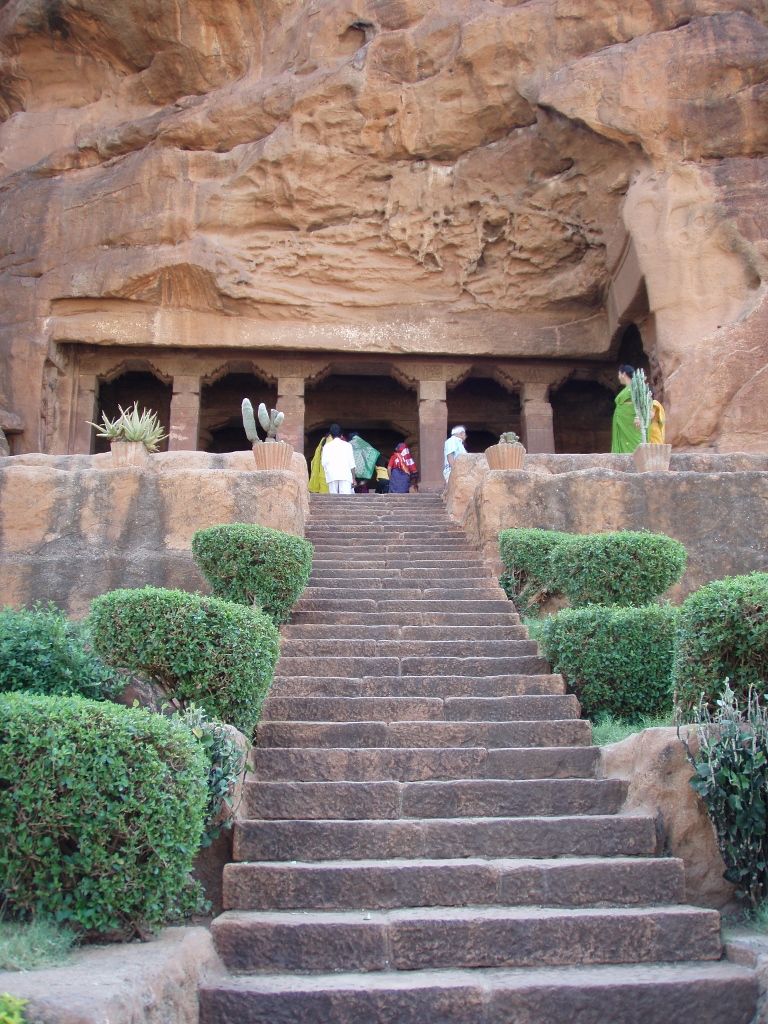 Access to Cave 1 chiselled out in the red sandstone
Access to Cave 1 chiselled out in the red sandstone
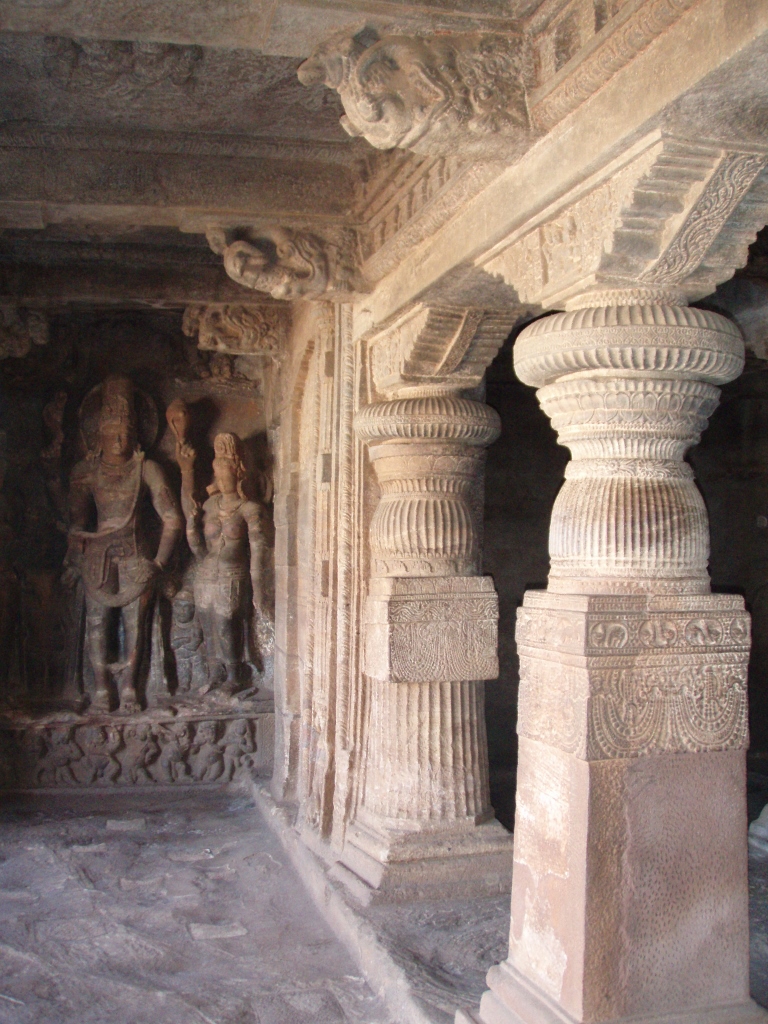 Wall of the veranda left from the entrance and the pillars that separate the veranda and the central hall in Cave 1
Wall of the veranda left from the entrance and the pillars that separate the veranda and the central hall in Cave 1
In the central hall there is a partially damaged sculpture of Nandi. Nandi is usually shown in the form of a bull and this is a deity that is the guardian of the gate on the holy mountain Kailasa, the abode of god Shiva. Nandi is a very much revered Hindu deity and there are often separate temples with large sculptures in the shape of a bull.
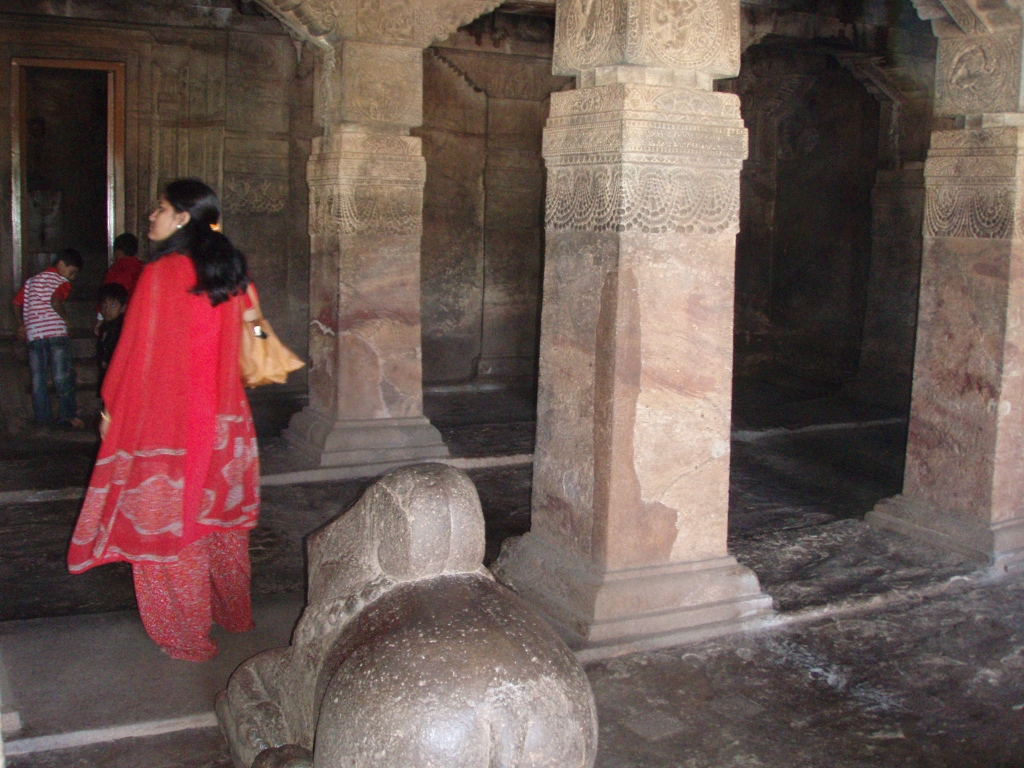 Central hall: Nandi is in front, while to the left in the back of the hall there is the shrine with Shiva’s lingam
Central hall: Nandi is in front, while to the left in the back of the hall there is the shrine with Shiva’s lingam
Like in the case of all these caves, there are many carved parts in Cave 1 as well, not only in the shape of low reliefs on the pillars, but also as very high reliefs on some wall panels. The most interesting one here shows Nataraja, which is a form of Shiva shown as a dancer with 18 arms.
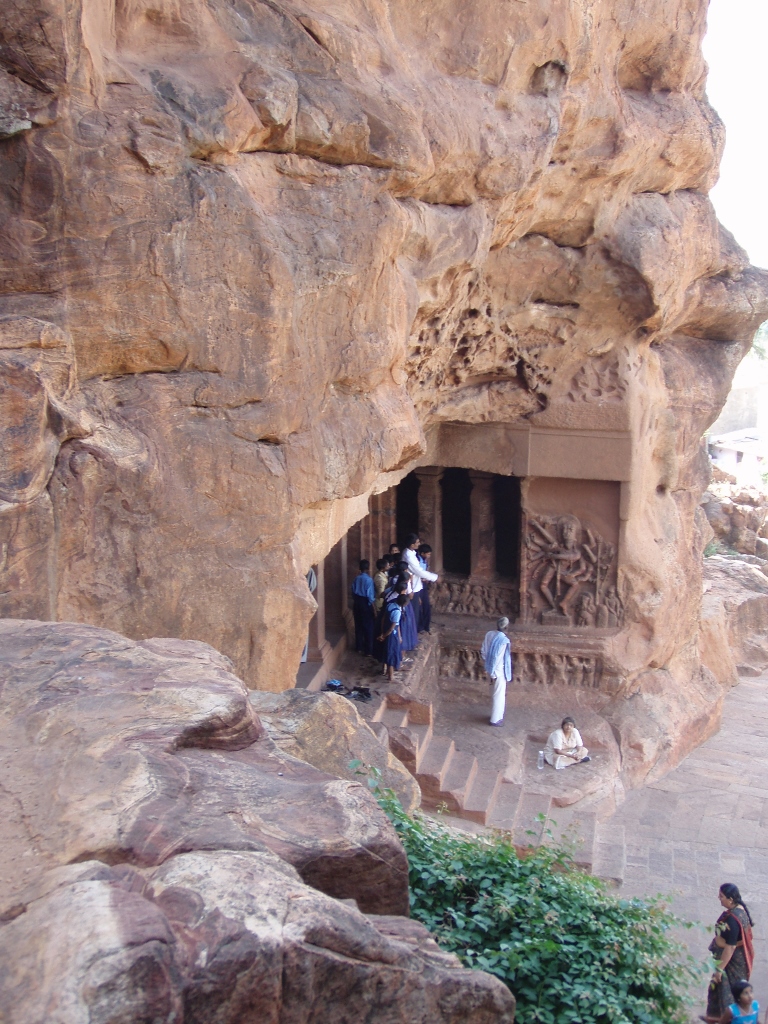 View at the entrance into Cave 1 in Badami; dancing Shiva can be seen straight on the panel
View at the entrance into Cave 1 in Badami; dancing Shiva can be seen straight on the panel
Although these temples are not active, we saw that before entering the local visitors took off their shoes without any exception, so the two of us followed suit. We did not know if anybody would warn us or prohibit that we entered the caves if we tried to do it in our footwear. With time this certainly became our absolute habit and we believed that this was a minimal thing we could do to show our respect for the holy places we were visiting.
Later, even in some other countries (e.g., in Sri Lanka), it was precisely the two of us who drew the attention of some inconsiderate or only clueless tourists to the fact that they should take their shoes off. If somebody does have a problem with walking barefoot, it is possible to bring socks and walk in them, or if there is somebody who does not want to follow this custom then they should not visit these places at all.
Around the temples and these caves there were a lot of monkeys, but we had already been told to be careful because even if they are small, they can be quite aggressive and therefore dangerous as well.
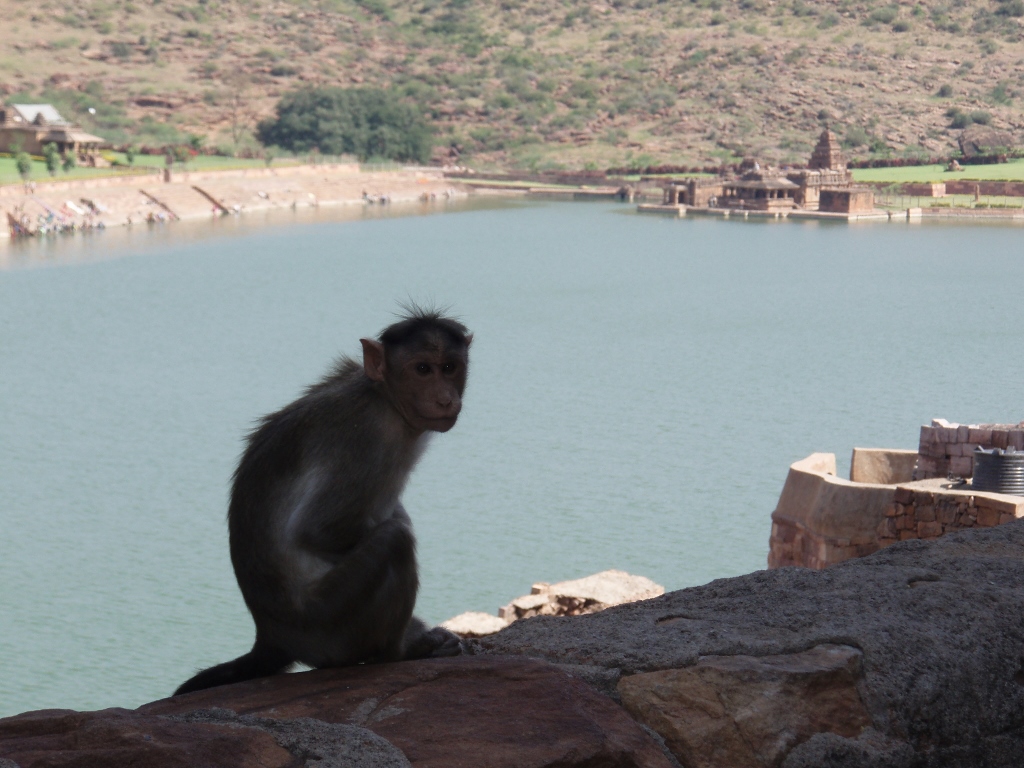 A local dweller and Agastya lake (in the distance there is Bhutanatha temple)
A local dweller and Agastya lake (in the distance there is Bhutanatha temple)
Then we went to Cave 2 which is smaller than the previous one and is dedicated to god Vishnu. In the following photo it is possible to see nicely a frieze at the base of the temple that consists of pot-bellied dwarves. By the way, the fifth avatar of god Vishnu, and he had ten of them, is Vamana, i.e., a dwarf, so I presume that in this way it was also emphasised who the temple was dedicated to.
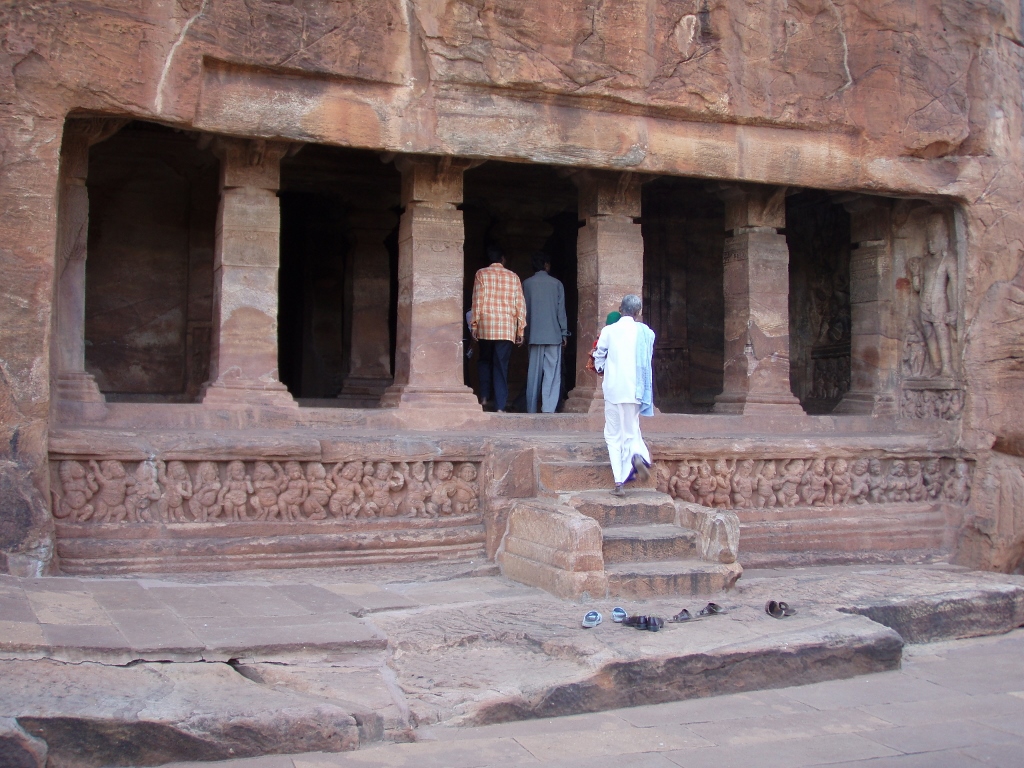 Entrance into Cave 2
Entrance into Cave 2
The most interesting part of Cave 2 is certainly a high relief on the left-hand side wall that shows Varaha, an incarnation of god Vishnu in which he has the head of a wild boar. Varaha was also the emblem of the Chalukya empire. In addition, the relief shows Naga, a lesser divinity in the shape of a serpent with a human head, while in the bottom there are again pot-bellied dwarves.
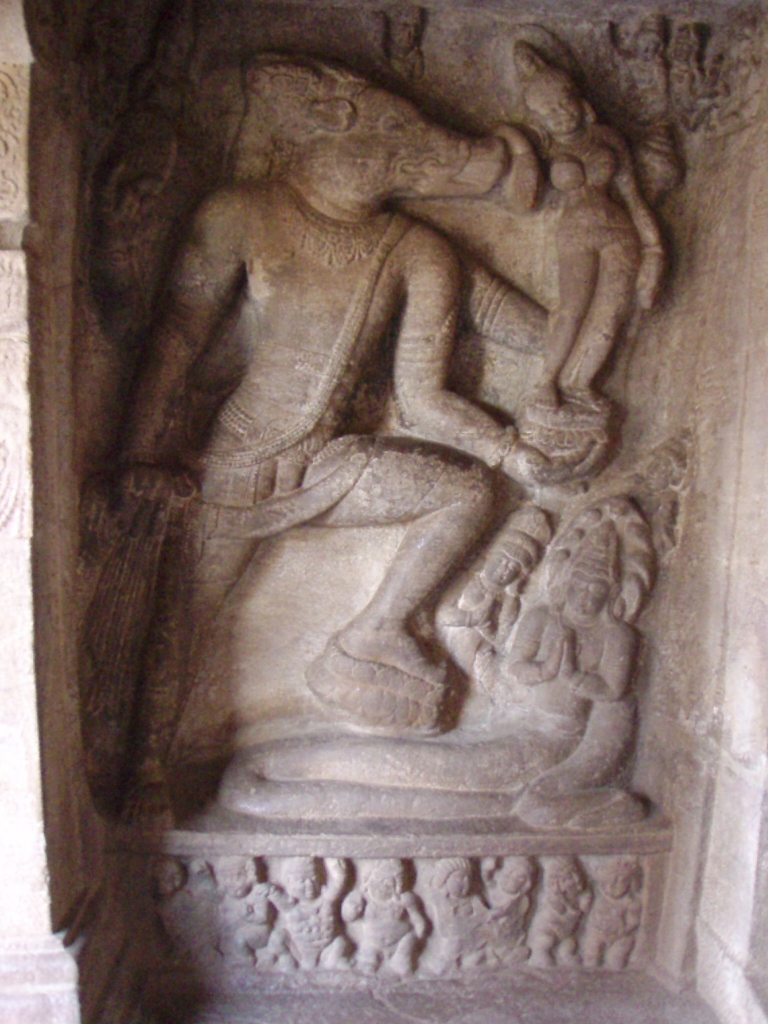 Varaha, Naga (right, under the feet of Varaha) and the dwarves at the very bottom
Varaha, Naga (right, under the feet of Varaha) and the dwarves at the very bottom
Then we got to Cave 3 which is the biggest one in Badami. It contains an inscription that says the cave originates back in 578.
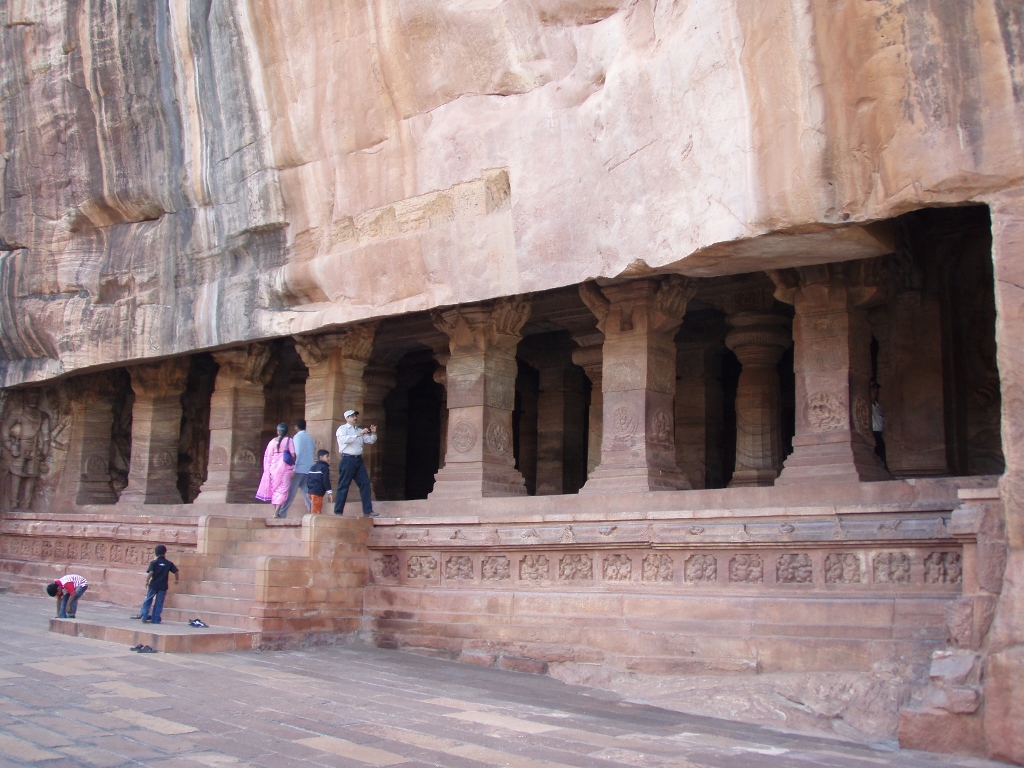 Cave 3
Cave 3
The veranda is 21 metres long, while the central hall is 15 metres deep and has the height of 4.5 metres. In the back of the cave there is a small room with the shrine called garbhagriha and this is the holiest place in the entire temple. The cave-temple is very richly decorated, starting from the pillars with opulent ornamentation on the capitals to the high stone reliefs on the wall panels. There are relief decorations on the ceilings as well.
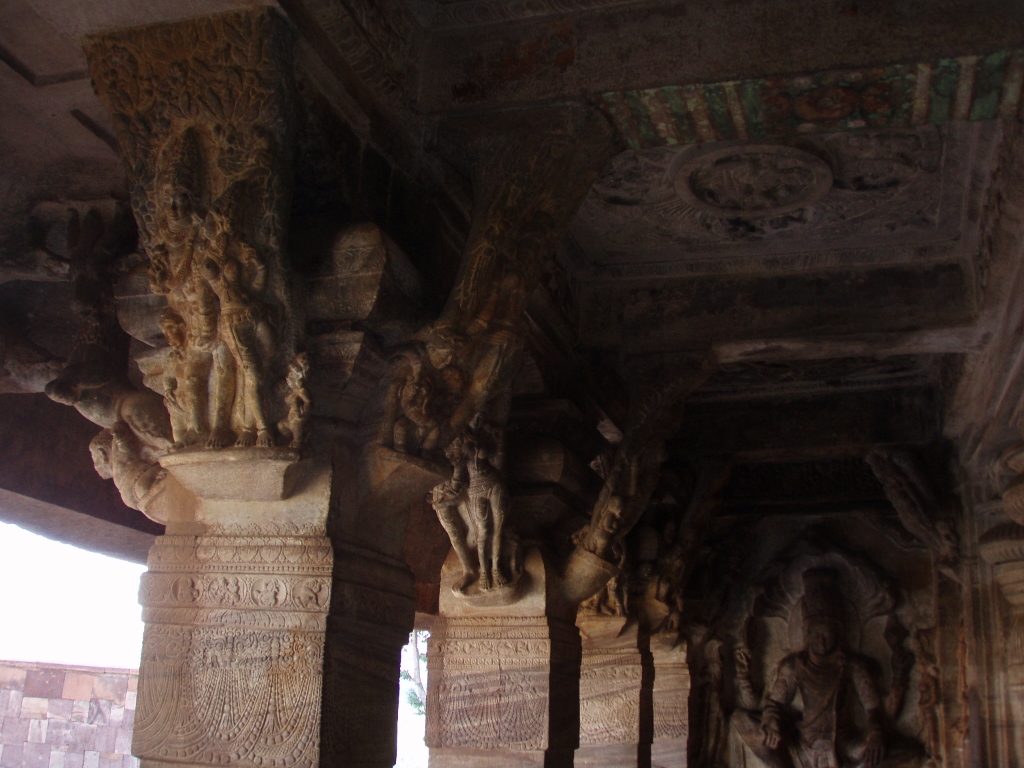 Parts of the veranda
Parts of the veranda
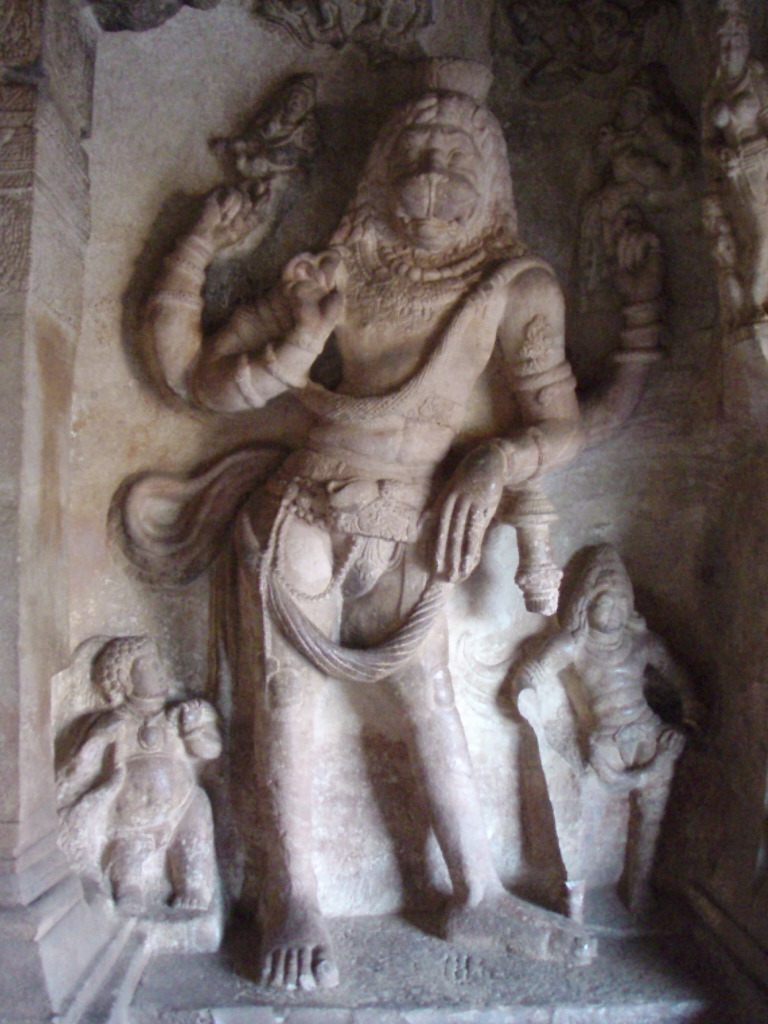 Narasimha
Narasimha
When one enters the veranda, on the right-hand side there is a panel and on it a high relief of Narasimha who is the fourth avatar of god Vishnu (photo above). This is a man with the head of a lion that has four arms and here he is standing in a very relaxed pose. However, precisely on the opposite side of the veranda there is the most important high relief in Cave 3 and this is the impressive depiction of Vishnu with four arms sitting on snake Adishesha whose five heads spread protectively above his crown. By his legs, there is Garuda as well. As a reminder, Garuda is half-man half-eagle and that is the vehicle or the carrier of Lord Vishnu.
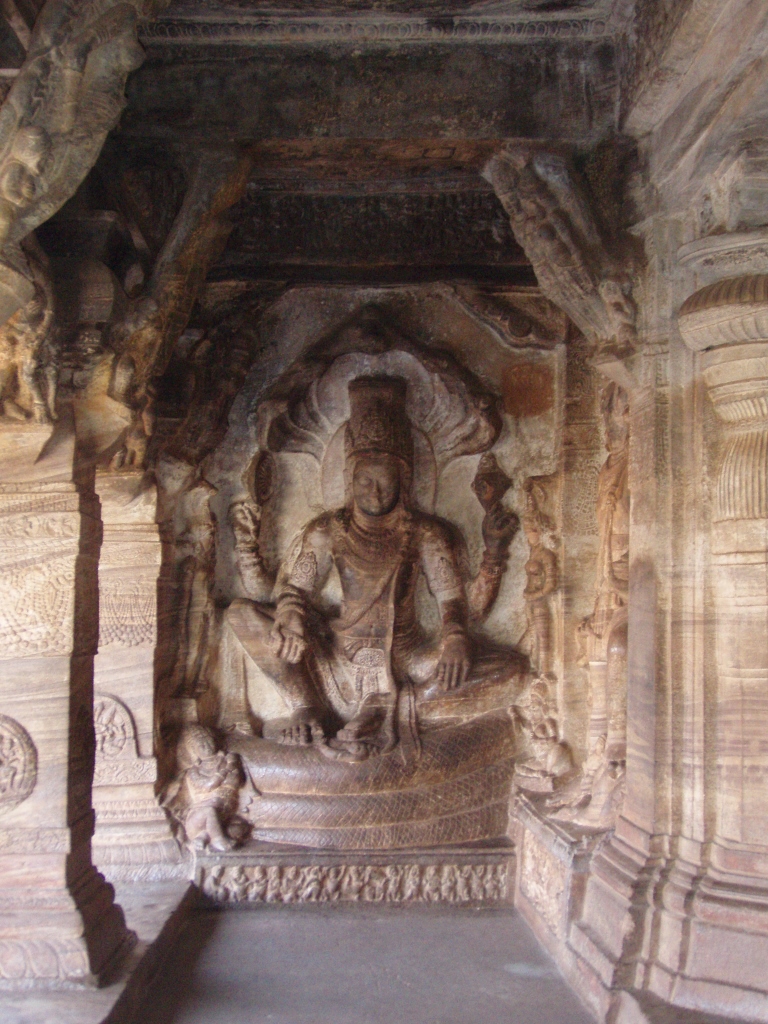 Vishnu on snake Adishesha
Vishnu on snake Adishesha
In the central hall it was quite dark, but I did not want to use flash, so there are no photos from the inside, but I did take a few more once I was out.
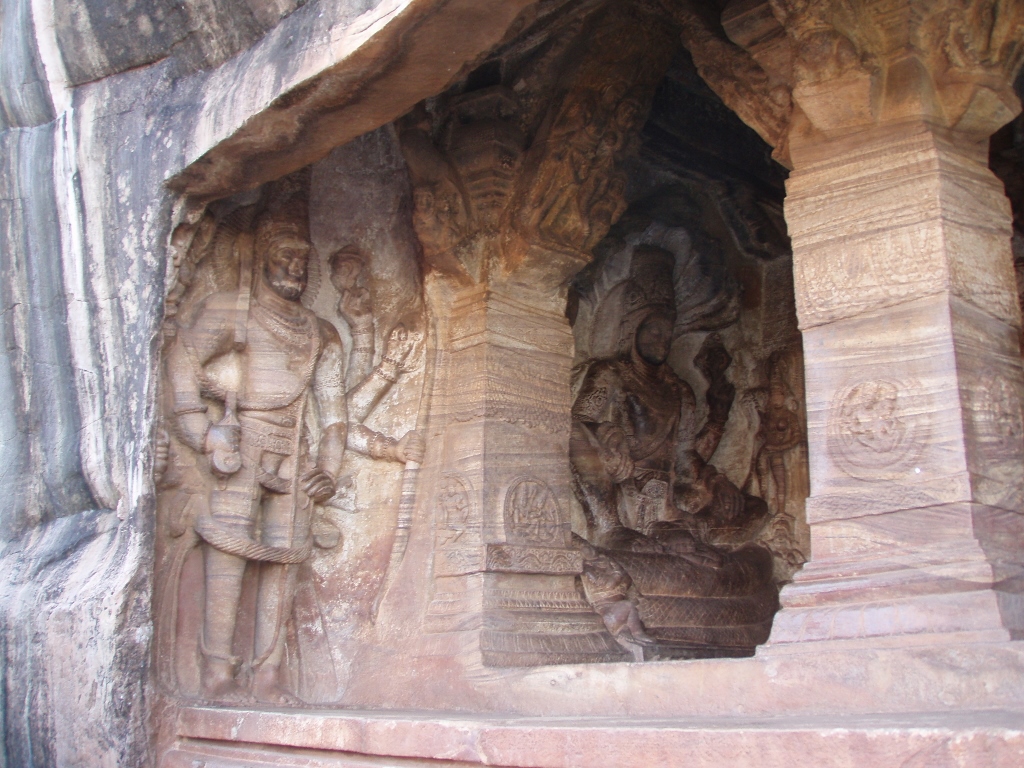 Depiction of god Vishnu on the left and on the right as part of the veranda decoration there is Vishnu on snake Adishesha
Depiction of god Vishnu on the left and on the right as part of the veranda decoration there is Vishnu on snake Adishesha
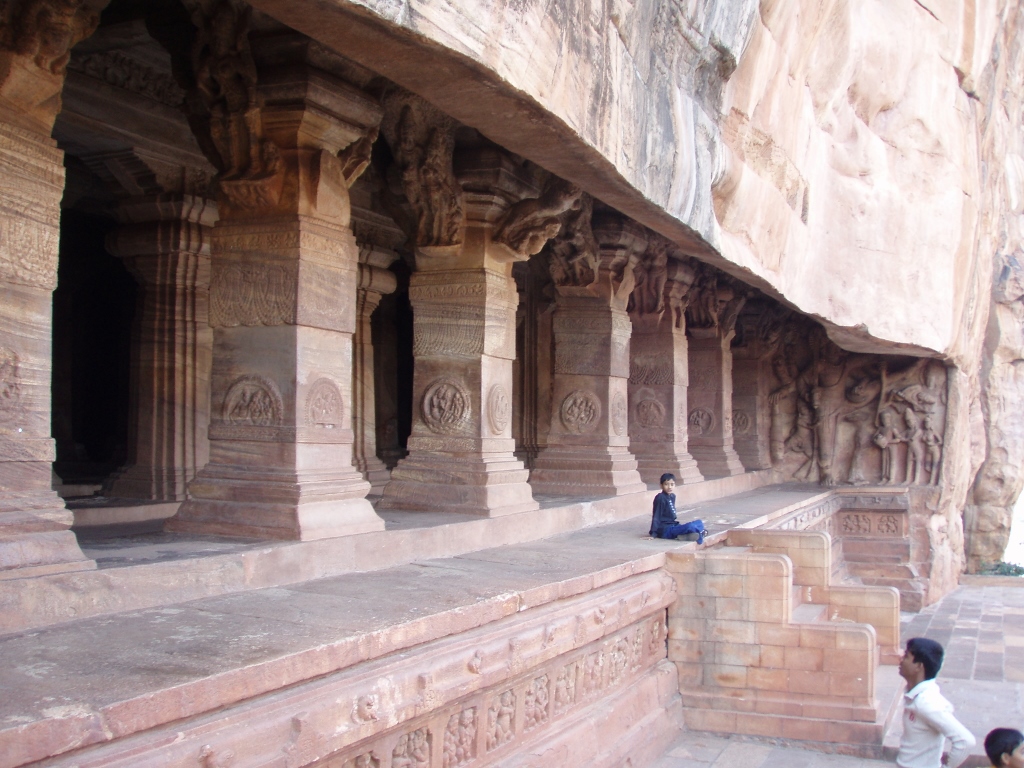 Entrance into Cave 3; in the back there is a depiction of Trivikrama, a giant form of Vamana, the avatar of Vishnu in the shape of a dwarf (don’t ask me why a giant form when this concerns a dwarf)
Entrance into Cave 3; in the back there is a depiction of Trivikrama, a giant form of Vamana, the avatar of Vishnu in the shape of a dwarf (don’t ask me why a giant form when this concerns a dwarf)
In front of these cave-temples there are also terraces from which there is a lovely view at the surroundings, as well as village Badami.
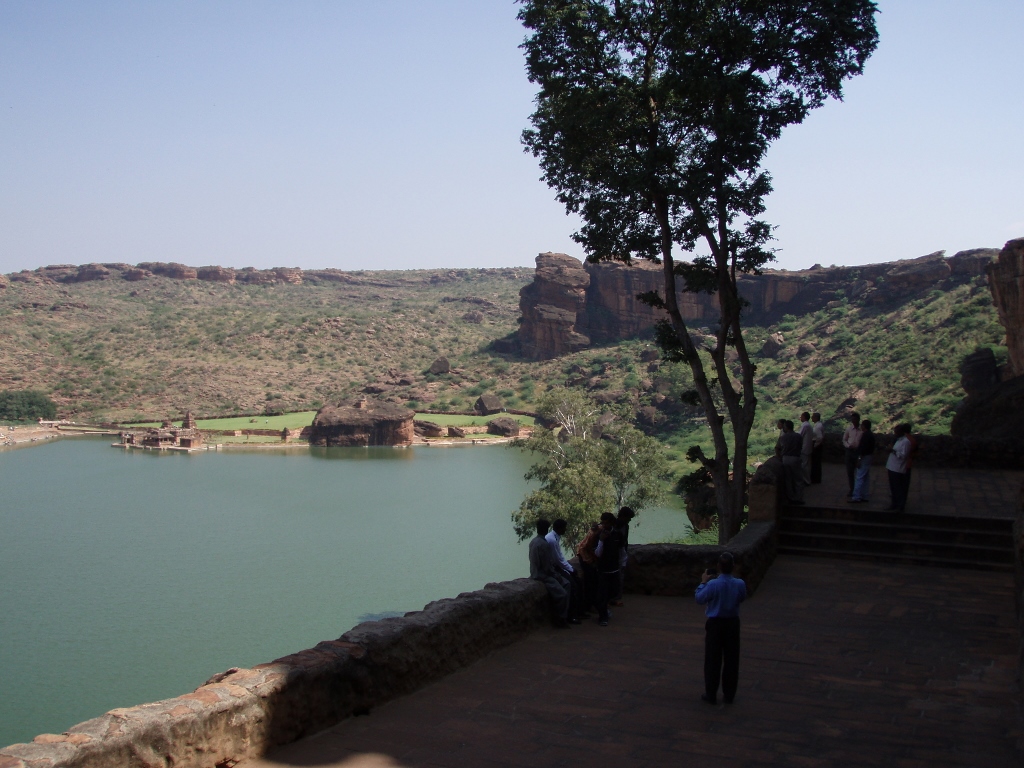 Agastya lake (in the distance there is Bhutanatha temple)
Agastya lake (in the distance there is Bhutanatha temple)
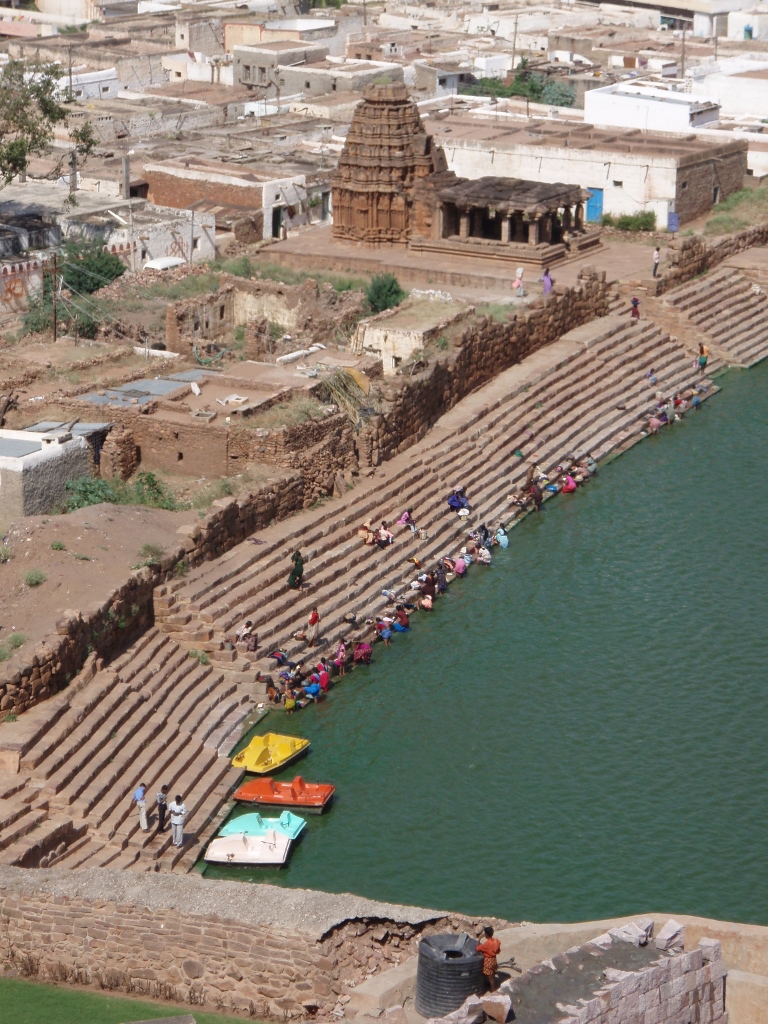 A part of the village and the lake
A part of the village and the lake
And then we also went to Cave 4. It is interesting because it was dedicated to Tirthankaras, the 24 original spiritual teachers of Jainism and Jainism is one of the oldest religions in the world.
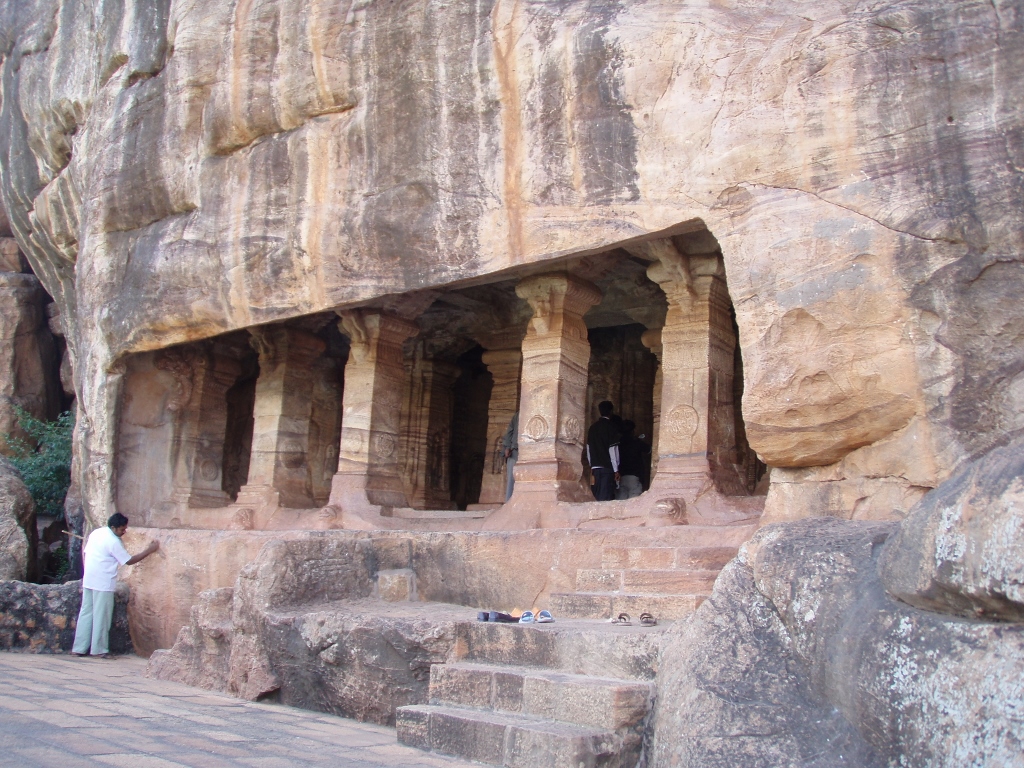 Cave 4
Cave 4
It is precisely in the garbhagriha, the shrine of Cave 4, that it is possible to see the sculpture of Mahavira who was the 24th Tirthankara.
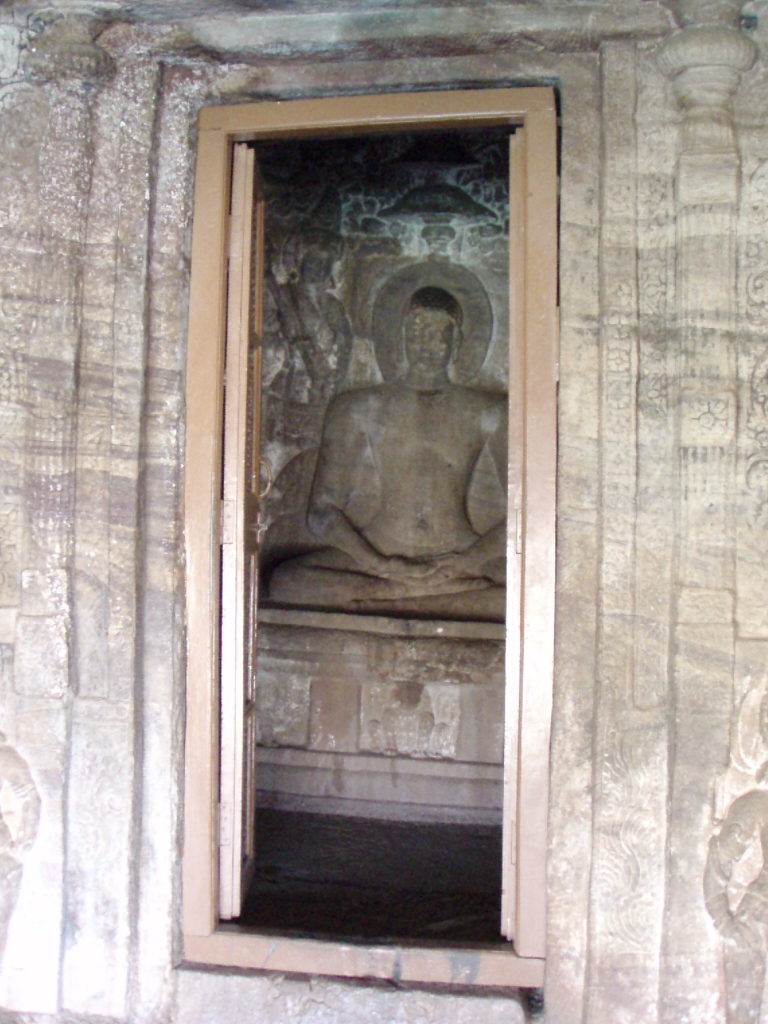 Mahavira in the garbhagriha of Cave 4
Mahavira in the garbhagriha of Cave 4
Since Cave 4 was dedicated to the holy persons of Jainism, then the decorations on the walls here differ from those in the previous caves.
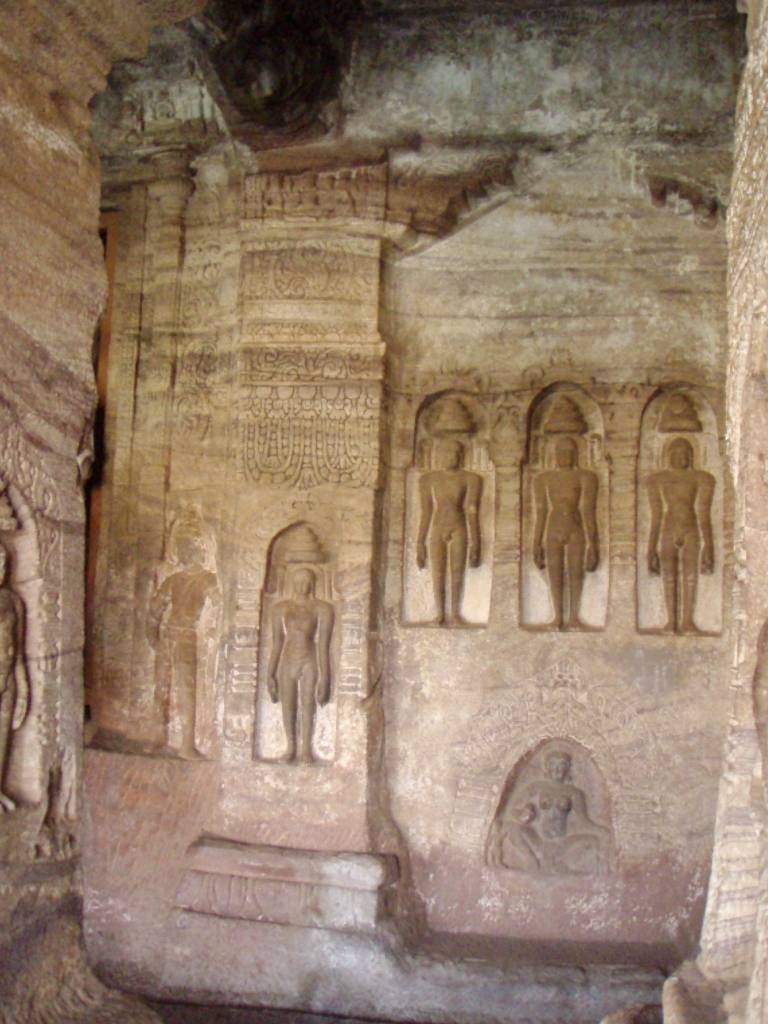 Walls in Cave 4
Walls in Cave 4
Following our visits to the caves, we went down venturing into the village a little and we also went to the lake. There was quite a lot of litter around and in one corner of the lake there was a lot of pond scum that was so thick it resembled paint.
We did not stay there for too long, however, since there was still plenty left to be seen, but it was also the time for lunch, so at the proposal of the driver we made a stop at a hotel along the way.
While we were going in the direction of Pattadakal, again we saw women carrying big bundles of grass on their heads, but we also saw them carrying big water containers in the same way. This is certainly very heavy, in addition to which it also requires major skill, but still they seemed so elegant even when doing such difficult work that I felt almost like asking them to give me a lesson on femininity.
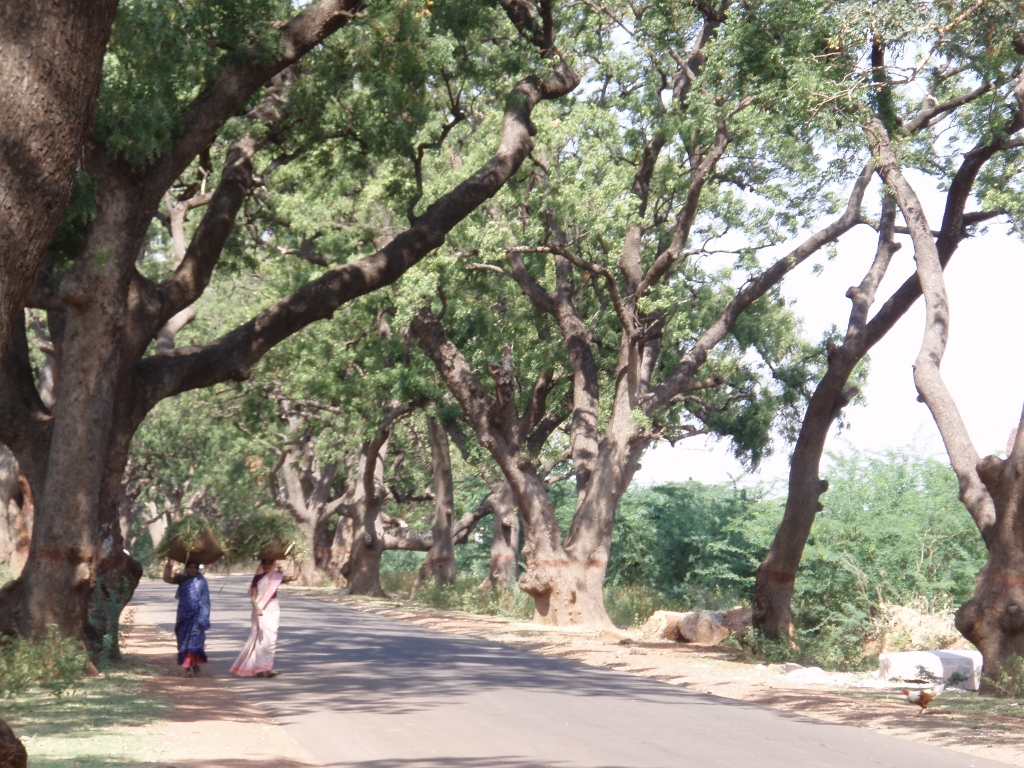 On the road from Badami to Pattadakal
On the road from Badami to Pattadakal
The reason why we were going to Pattadakal now was that there is yet another very important spiritual centre there from the times of the reign of the Chalukya dynasty. Practically, this concerns a group of monuments that includes nine Hindu and one Jain temples, and together they constitute a cultural property that is included in the UNESCO’s World Heritage List.
At around one kilometre before the main group of the temples in Pattadakal, Sneža and I visited a Jain temple that was built in the 9th century CE during the reign of the Rashtrakuta dynasty. This is the dynasty that ruled between the early Chalukya dynasty and the Western Chalukya Empire.
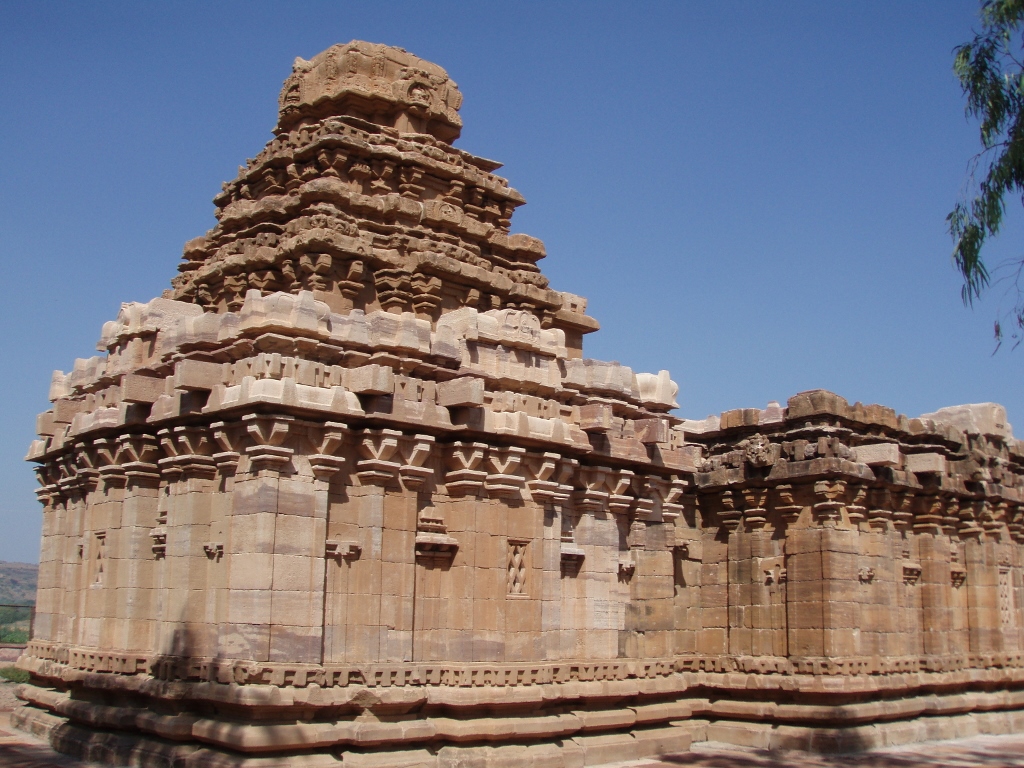 Jain temple in Pattadakal
Jain temple in Pattadakal
At the temple there is an interesting mandapa (an open hall the interior of which is filled with pillars) which in addition to the pillars also has a couple of rather big chiselled elephants that greet the visitors on both sides of the passage that leads into the central hall.
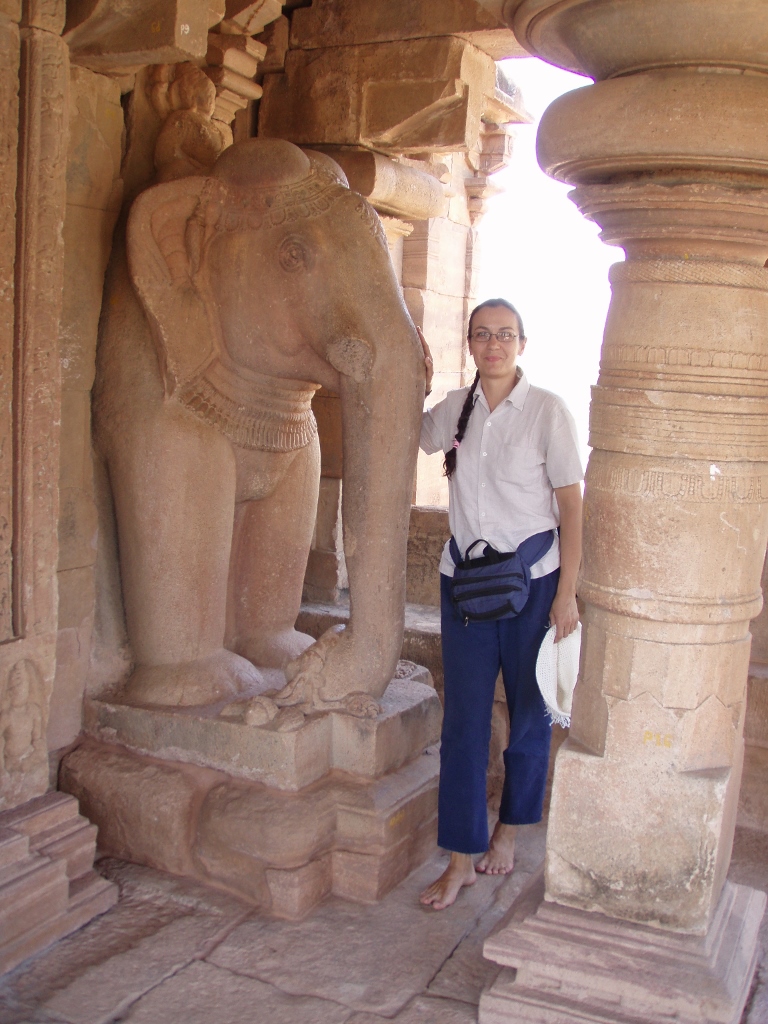 Welcome elephant at the Jain temple
Welcome elephant at the Jain temple
The interior was also interesting. What caught my eye was that in the central shrine there was Shiva’s lingam which did not make sense since Shiva is a Hindu god, but I found some information that says that the lingam was probably placed there later when the influence of Jainism in this area was on a decline.
Within the temple, around the shrine there is a narrow passageway. We headed that way, but ended up waking up a napping bat. Since it was unclear who was more startled by this unexpected encounter, the two of us quickly left the temple.
Then we were taken to the site where there is the main complex of the temples jointly called Pattadakal. In a word, they leave one breathless. The two of us visited it all, we took photos and filmed with a video camera and yet in the end I had an impression that we rushed through it. I almost had a desire to touch each pillar, to look closely at each relief and sculpture. And we did a lot of it, but I wish we had done more.
The holy complex in Pattadakal with temples from the 7th and the 8th centuries constitutes yet another pivotal artistic creation of the kings from the Chalukya dynasty. As opposed to Badami, where there was a settlement and therefore those temples there were used for daily purposes, here there were almost no durably settled people and these temples were mostly used for ceremonial purposes – royal celebrations and coronations.
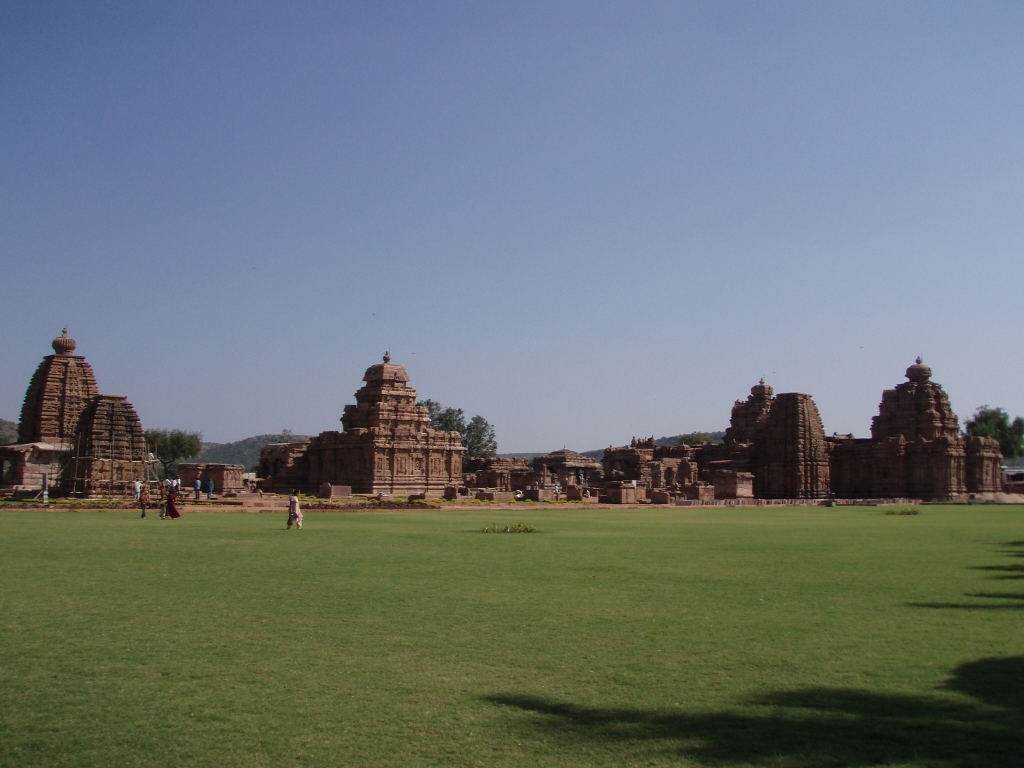 Temple complex in Pattadakal
Temple complex in Pattadakal
The first temple we came across was the small Kadasiddeshvara Temple. It was already here that we started to learn about two different architectural styles when it comes to the construction of Hindu temples and Pattadakal is considered the textbook for this, since both styles are present.
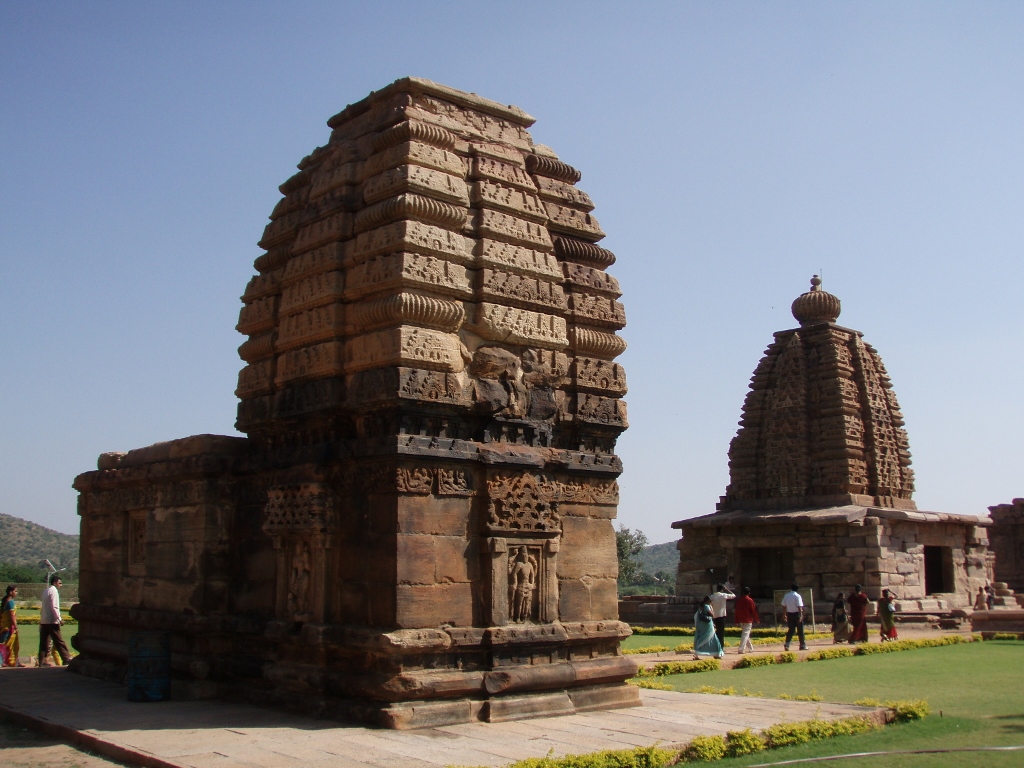 Kadasiddeshvara Temple (left) and Galaganatha Temple (right)
Kadasiddeshvara Temple (left) and Galaganatha Temple (right)
Namely, there are the so-called North and South Indian temples. They differ by many details, but one of the most visible ones for laymen such as I is the shape of the tower that rises above the interior shrine garbhagriha.
In north India, this tower has a more or less curved shape and is called shikhara, and on top of the tower there is by the rule a circular ribbed decoration called amalaka. Both temples in the photo above belong to the North Indian temple type.
The temples in south India have a tower that is more of a pyramidal shape and in that case the tower is called vimana. On the top of the vimana there is a hemispherical, barrel-vaulted roof or a roof of some other similar shape.
Precisely in the next photo you can see both styles one next to the other – the North Indian temple is on the left, while the South Indian temple is on the right-hand side.
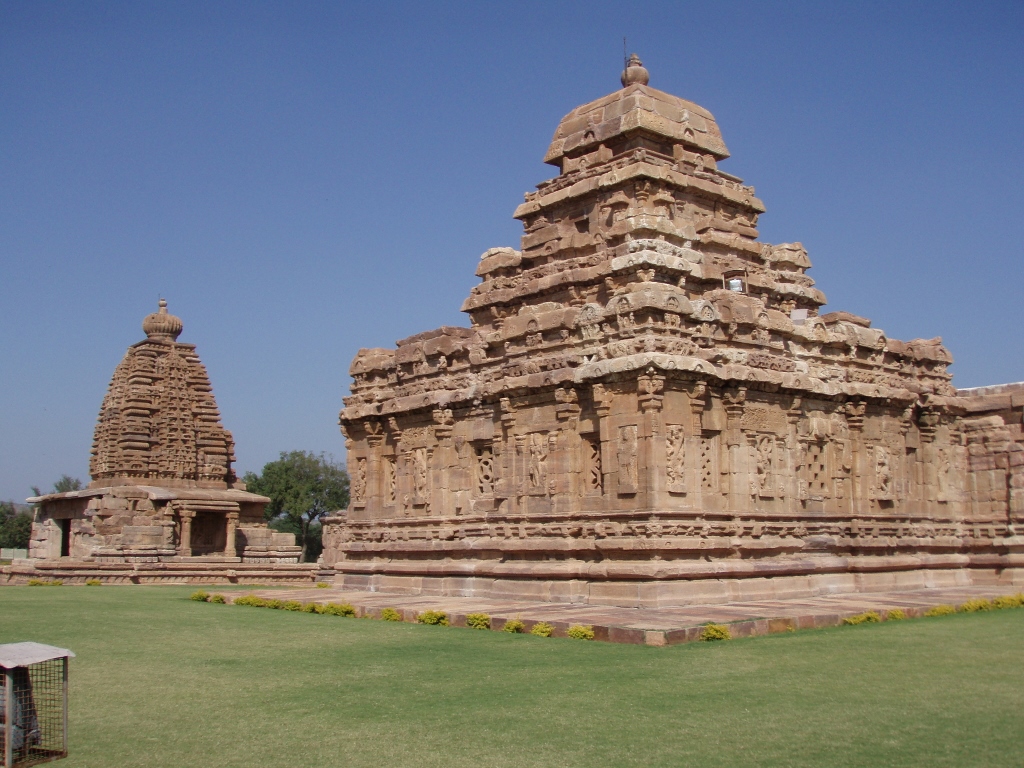 Galaganatha Temple (left) and Sangameshvara Temple (right)
Galaganatha Temple (left) and Sangameshvara Temple (right)